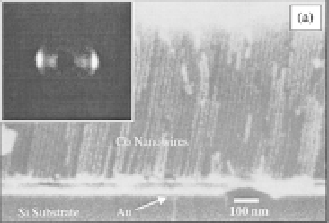Biomedical Engineering Reference
In-Depth Information
ease of solution coating the template film over general patterned
substrate geometries.
Photodegradable components such as PMMA offer the
possibility of being selectively etched away from regions exposed
using standard photomasks or directed electron beam lithography.
Patterning in this way adds another degree of freedom to that offered
by patterning the working electrode itself. Bal
et al.
demonstrated
this process using 50 μC/cm
2
electron beam exposure of an electric
field aligned PS-
-PMMA template, followed by “developing” in acetic
acid [80]. Cobalt nanowires were electrodeposited in the exposed
pores on top of a patterned Au substrate (Fig. 2.15).
b
Figure 2.15
(a) Cross-sectional SEM image of electrodeposited Co
nanowires in a porous PS template (small angle X-ray scattering pattern
inset). (b) Optical micrograph of a four-probe patterned Au substrate
after Co elecrodeposition (schematic cross-section inset). Reprinted with
permission from Ref. [80]. Copyright 2002, American Institute of Physics.
2.4.6 Biconinuous Gyroid Copolymer Templates
The technological challenges associated with vertical alignment of
cylinder-forming templates can be avoided by targeting the gyroid
(G) phase, comprising two interwoven continuous networks of the
minority component held in a matrix phase of the majority block
[81]. Since
minority and majority phases are continuous in all
three dimensions, the structure is termed
both
. If surface
reconstruction (Section 2.3) can be avoided, templates made from
the gyroid phase are spontaneously porous upon removal of the
minority networks without any further alignment.
bicontinuous










Search WWH ::

Custom Search